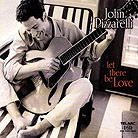April 2001
This disc is Pizzarelli’s second recording for the Telarc label, and his twelfth overall. Not much has changed for Pizzarelli since he burst onto the scene with his Chesky release, My Blue Heaven, in 1990. He still looks to the great American songbook for inspiration, and he’s still straddling that fine line between jazz and schmaltz. Pizzarelli also seems to record habitually for labels that offer better-than-average sound quality, Chesky, RCA, and now Telarc. To be sure, Pizzarelli is a fine interpreter of those hoary old songs, and has, for the most part, looked not just to rehash them, but to re-imagine them as well. And he can write new tunes that segue perfectly with the standard repertoire. He has a unique performing style that lends itself very well to this type of music. Yet, I can’t help believing that, with his talent, he could be doing so much more. He could be the successor to Jim Hall as the pre-eminent jazz guitarist of the times. Unfortunately, at this point in his career, I don’t think that’s going to happen. Pizzarelli has found something he’s both good at and enjoys, and will more than likely stick to it. Pizzarelli "set out to make an album that was a spontaneous expression of what it feels like to be ‘in love’ from wedding day, to everyday, to the occasional rainy day. I wanted this album to feel personal and romantic, as if you had happened upon us playing for friends in our living room late at night." He succeeds in spades. This is a Y2K make-out album if ever I heard one. Had it been recorded 45 years ago, we would have called it "bachelor pad" music. Pizzarelli owns a beautiful baritone voice, and he puts it to good use here, holding forth with a smooth, even presentation. A good example of his vocal talents lies in what I consider the best cut on this disc, "Da Vinci’s Eyes," a tune Pizzarelli wrote to lyrics written by his wife. He shows a real feeling for this song, as one would expect given its origin. "Da Vinci’s Eyes" is a tender song that draws you in and holds your attention. Additionally, the inclusion of cello (Jesse Levy), accordion (Dominic Cortese), tenor sax (Harry Allen) and clarinet (Ken Poplowski) make this piece of more than passing interest, both sonically and musically. The sound here, due to the sparse instrumentation, varies from very good to almost great. Listen to the breath of the tenor sax player on "All I Saw Was You," or to the way you can tell that the clarinet is made of real wood on "Stompin’ At The Savoy." It’s also easy to tell that Tony Tedesco is using his brushes, not on a drumhead, but on something else (OK, for those of you who just have to know, it’s a book). There is also plenty of space for each instrument to stretch out, so you can hear how each interacts with the recording venue as well as the other instruments. And yet, in spite of all its strengths, I just can’t build up any real enthusiasm for Let There Be Love. While I enjoyed it for what it was, it strikes me more as Muzak (or light jazz) than real jazz. It is, however, extremely well recorded, so it might become a demo disc for your system’s resolving capabilities. And as a "put it on, grab your loved one and pitch some woo" backdrop, it’s hard to top. Other than that, it’s an acquired taste -- but if it’s one you’ve acquired, you’ll love Let There Be Love. GO BACK TO: |
 John Pizzarelli - Let There Be Love
John Pizzarelli - Let There Be Love![[Reviewed on CD]](../format/regcd.gif) Where
does one draw the line between jazz and Muzak™? And where does John Pizzarelli fit
into the equation? Those are some of the questions prompted by listening to Let There
Be Love, Pizzarelli’s latest release for Telarc.
Where
does one draw the line between jazz and Muzak™? And where does John Pizzarelli fit
into the equation? Those are some of the questions prompted by listening to Let There
Be Love, Pizzarelli’s latest release for Telarc.